The annular solar eclipse of September 1st, visible over south-central Africa and parts of the Indian Ocean, was a dazzling crowd pleaser!
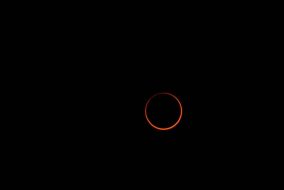
Jay Pasachoff
September's annular eclipse has come and gone, but not before putting on a brilliant show for those fortunate enough to find themselves positioned along the center line of eclipse path. Annular solar eclipses are a close relative to total eclipses, in that we see them when the Moon passes directly in front of the Sun from our vantage point on Earth.
However, if the Moon's passage occurs close to when the Moon reaches its orbital apogee, the lunar disk appears just a bit smaller than average. So, unlike during a total solar eclipse, the Moon doesn't quite cover the entire the Sun. At what would otherwise be the "total" stage of the eclipse, brilliant sunlight beams out around the Moon's edges, creating an appearance of a "ring of fire."
Satellite images taken during the eclipse and shared by the European Organisation for the Exploitation of Meteorological Satellites (EUMETSAT) show that the clouds interfered with visibility for some viewers in the north, but didn't much bother the rest of those anticipating a great show. While the best views of the annular stage, which lasted three minutes, were from the region of Tanzania and Madagascar, observers in other locations around the African continent and Indian Ocean still witnessed a satisfying partial eclipse.
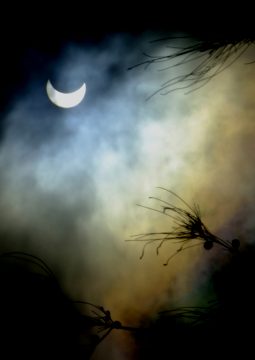
James T. Trimanez
The partial phase was visible as far north as Aswan, Egypt. At 3% coverage, that's a tiny slice of darkness! We're seeing some dramatic images of the partial phases from elsewhere on the continent, like the moody view captured in Kenya shown here at the right.
Ahead of the event, most eclipse-chasers seem to be headed for Tanzania and Madagascar, locations where meteorologist Jay Anderson predicted the chance of sunny skies would be the greatest. And indeed, Tanzania had wonderfully clear skies.
Many observers watched the eclipse safely with eclipse glasses or by creating projections with pinholes or colanders. But we also received multiple reports of people in Kiglai (Rwanda) and the Jos Plateau (Nigeria) watching the eclipse by viewing the Sun's reflection in a basin or bucket of water.
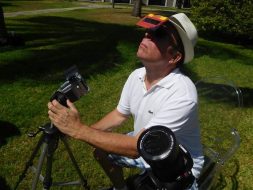
Jay Pasachoff
Eclipse specialist Jay Pasachoff (Williams College) joined a group of travelers for some more high-tech viewing on the French island of Réunion, east of Madagascar. He reports that they enjoyed clear skies with an occasional passing cloud.
Viewing for tourists and island residents was facilitated by the Observatory of Makes (Observatoire Astronomique des Makes). The observatory reserved space with a HD projection screen at a football stadium in Saint-Louis for the public and astronomers alike. Réunion was also selected by the Paris Observatory (Meudon) for its official observation site. If you didn't see the eclipse in person, you can watch this high-definition video of the eclipse recorded by astronomers from the Paris Observatory to get an idea of annularity.
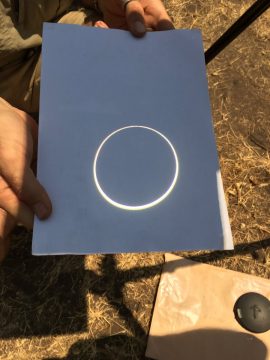
Ryan Milligan
Today's annular solar eclipse will be followed by a lunar eclipse two weeks from now, on September 16, 2016, when the Moon reaches full. However, this one will hardly be visible, a "barely there" penumbral event. Observers in Europe, Africa, and Asia should see a slight darkening of the Moon's northern half. Looking up? Let us know what you see.
And don't forget next year's big event. On August 21, 2017, observers in North America will witness a total solar eclipse, a coast-to-coast event. Total solar eclipses somewhere on Earth about every 18 months, but there hasn't been one in the contiguous United States since February 26, 1979. It's been a long wait for another one, but the good news is, this one will be observable, at least in its partial phase, across the entire country. The path of totality is about 70 miles wide and stretches across 14 states, beginning with Oregon and ending with South Carolina. If you're anywhere along the center line of the eclipse, you'll see at least 2 minutes of totality. That's worth making a trip north, south, east, or west! Check out the S&T Guide to the August 2017 Total Solar Eclipse so you can start making plans for the big day.
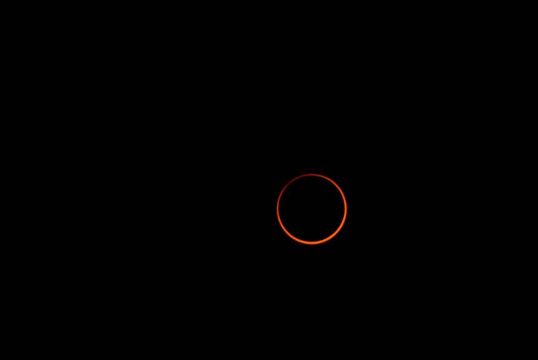
Jay Pasachoff
 2
2









Comments
September 2, 2016 at 9:14 am
"Many observers watched the eclipse safely with eclipse glasses or by creating projections with pinholes or colanders. But we also received multiple reports of people in Kiglai (Rwanda) and the Jos Plateau (Nigeria) watching the eclipse by viewing the Sun's reflection in a basin or bucket of water."
Unfortunately, we saw photos on Twitter of people in Africa attempting to view the annular eclipse using film negatives. We hope nobody suffered eye damage as a result. This hammers home the vital necessity of doing everything we can to promote safe solar viewing procedures for the 2017 eclipse, and all other solar eclipses.
You must be logged in to post a comment.
Paul_Kebabian
September 2, 2016 at 5:39 pm
Did anyone see shadow bands at this eclipse? At the annular eclipse in 1994, I recorded them electronically even though they were not visible to the eye (nor to film). I plan to try again in 2017!
You must be logged in to post a comment.
You must be logged in to post a comment.